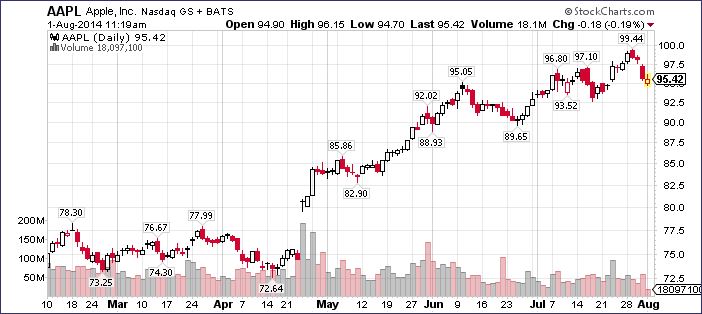Apple got so close to $100 last week that shareholders such as myself could almost taste it. But alas, it wasn’t to be. However, it will be interesting to see if $100 provides significant resistance for the stock moving forward.
If you have watched stocks trade for any significant amount of time, you have certainly noticed that “round numbers” such as $100, $50, $10, and $20 often provide resistance levels or support levels for stocks.
Do these numbers possess a magic power? Your common sense should tell you that they don’t. So what’s the deal? Round-number resistance and round-number support can be self-fulfilling prophesies. I discuss self-fulfilling prophesies in my book:
Self-fulfilling prophecies are predictions about the future that end up coming true not because of the validity of the prediction, but rather because the people aware of and involved in the prediction adjust their behavior in some way to make the prediction come true. This self-fulfilling prophecy effect is a major reason why some people believe in psychic powers. If a psychic tells someone they will find true love within a year, that person might be more receptive and confident than they usually are when they go on dates, might be more likely to overlook relationship flaws, and might be more trusting of their partners. If you come away with nothing else from this book, I want you to remember this: the stock price of a company does not directly reflect the value of the company; it is a direct measure of the price someone is willing to pay for a share of stock. There are lots of valuation metrics that are designed to determine how much a share of stock is “worth.” However, at the end of the day, the share is worth exactly what someone is willing to pay for it. How else can you explain the continuous cycle of bull and bear markets over time? The stock market is a popularity contest, and investors’ perception of reality is far more important than actual reality.
But why round numbers? I’ve talked many times before about some common tools traders used to reduce risk and maintain discipline when trading: stop-loss orders and limit orders. When placing these orders, traders are basically “naming their own price” Priceline-style. For example, earlier this year I sold RF Micro Devices at $9.00 for a 100% return in about four months. I sold the stock when it hit that number because that was the limit price I had set for my sell order. Would I argue with someone who told me that RF Micro was valued at $9.13 per share. Nope. What about $8.98? No protest from me. And yet I chose $9.00 as my limit price because it was an even number (and it represented an exact double from my purchase price).
And I’m not alone. If you look at a stock that is trading near a round number, the percentage of stop and/or limit order targets that are within a few cents of that round number will likely be relatively high.
So here’s what happens: a stock such as Apple cruises along from $90 to $98 with little problem. Buyers slightly outnumber sellers, so the stock steadily rises. However, as Apple approaches $100 (the godfather of all round numbers) it will start to run into a traffic jam of limit sell orders. Since many traders are aware of this “round number” effect, they will set their limit sell orders slightly lower than the round number, at say $99.00 or $99.50. Sticking with the traffic jam analogy, stock price progress stops before you reach the pileup at $100 that represents the actual source of the jam.
And you get something that looks like this:
Apple got to within 46 cents of $100 and started seeing brake lights ahead. Since then, it has pulled back over 4% to about $95.00, which is a nice round number in itself.
But what does all this mean for shareholders? Not much. It’s just something to be aware of when you intend to set your target prices at even numbers. More than likely, you are not alone. And if you can manage to stomach an ugly target of something like $99.44 instead of a sexy target like $100.00, you might be able to save yourself a few weeks of waiting.
As for me, I have very high standards for sexiness, and not even $100.00 gets me in the mood when it comes to Apple. Even after Apple’s recent run-up, I still think the stock and the company have a bright future. And after all, there’s nothing hotter than a little bit of delayed gratification. For the right stock, I will wait as long as it takes.
Want to learn more about the psychology of the stock market? Or maybe you just want to be able to look sophisticated in front of your coworkers when they ask you what you are reading on your Kindle, and you’d prefer to tell them “Oh, I’m just reading a book about stock market analysis,” rather than the usual “Oh, I’m just looking at pics of my ex-girlfriend on Facebook.” For these reasons and more, check out my book, Beating Wall Street with Common Sense. I don’t have a degree in finance; I have a degree in neuroscience. You don’t have to predict what stocks will do if you can predict what traders will do and be one step ahead of them. I made a 400% return in the stock market over five years using only basic principles of psychology and common sense. Beating Wall Street with Common Sense is now available on Amazon, and tradingcommonsense.com is always available on your local internet!


